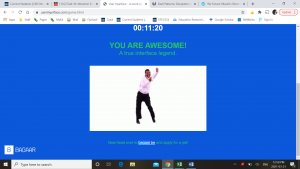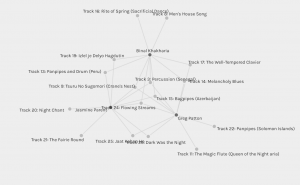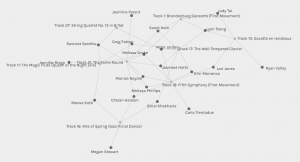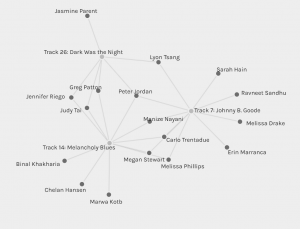“Simon Stålenhag (b. 1984) is the internationally acclaimed author and artist behind Tales from the Loop and Things from the Flood. His highly imaginative images and stories depicting illusive sci-fi phenomena in mundane, hyper-realistic Scandinavian and American landscapes have made Stålenhag one of the most sought-after visual storytellers in the world.”
https://www.salomonssonagency.se/simon-stalenhag
For this speculative assignment I decided to re-interpret two of Simon Stålenhag’s paintings as examples of the relationship between advanced technology and human culture. I am completely enthralled with his artwork and the mix of futuristic technological ideas and the everydayness of the backgrounds. I hope you find these stories enjoyable and thought-provoking.

https://www.simonstalenhag.se/bilderbig/ark_tess_big.jpg
Recording taken from surveillance mic in Smart Refuse Unit #14807; 8:38pm April 3/2054. Two voices heard: Simon (last name unknown) and Lang (no last name).
Simon: You comin’ to watch this? I thought this was your favourite show…
Lang: Meh… I’ve seen this episode like a million times. Besides, the clouds are starting to bug out and they haven’t turned on the powerplant exhaust outputs so I bet we get about two thirds of the show, tops before you can’t see shit.
Simon: Always so negative Lang… come sit down, shut up, and enjoy the light show.
Lang: (Sighs) Whatever. Ever since they cut public access to cable and started broadcasting TV outside in the sky, I’ve kinda tuned out. No choice anymore…
Simon: Well how else are you going to get people to go outside smartass? It’s bad enough that we have to stay away from everyone because that virus is so easy to catch, but locking ourselves inside all day and night kinda sucks ass. I’m stoked that we are allowed out to watch TV from 8-10; I can’t stand staring at the same walls all the time. And to get away from the family!! C’mon, you can’t stand being around Mom and Dad anymore than I can. “Lang, take the garbage out. Lang, go to the grocers and pick up these items. Lang, someone is knocking at the door. Answer it while we go in the shelter.” We have no freedom man… they just tell us what to do and we blindly obey… makes me sick.
Lang: Remember that time I got home from the store and we’d glued that fake dog shit onto my shoe and your parents saw it and started losing their shit and rushing around for their masks and everything? Fuck man, that was priceless… I can’t believe they didn’t kick me out of the house after that. It took us like 30 minutes to calm them down. (sound of both laughing) Who knew dog shit would be so scary?
Simon: Yeah, or that dogs would be the main carriers of this fucked up disease. Man, I miss Gordon. He was such a great dog… always ready to go hang out and play fetch at the park. So fucking pissed we had to put him down… so pissed.
Lang: You know your parents had no choice; it was the fucking law! What were they going to do? Let him go so he could be like these other bug carriers roaming around spreading disease everywhere they piss and shit? Had to be done man… had to be done. Now, you just gotta become a cat lover like me. Right Bert? (Cat meow heard)
Simon: You and that cat… unbelievable. How can you even like that thing? It barely acknowledges your existence… only reason he’s here right now is because he knows you have a can of food for him in your pocket. Cats are messed…
(Sound of can being opened)
Lang: Here ya go big guy… eat up. Yeah, whatever, Bert has been with me from before I moved in with you and that’s… what? Four years ago? Five? I don’t know, I’ve lost count… it’s all a blur. Like the show you’re watching! (laughs)
Simon: Five years smartass… Thank God you moved in. I was ready to throttle Mom and Dad by then. Just the three of us and no one else to really hang with. And Dad is so pathetic at video games… I mean at least he tried and shit, but man he would just sit there and bash buttons and end up trapped in the corner. I can’t even count how many times I had to mercy shoot him in the back just so we could keep moving.
Lang: Probably as many times as I’ve had to do it to you, sloth boy. Sometimes you are so slow at moving forward! My God! It’s like you get ADHD in there… Hey look!! Shiny object! Was that a squirrel? (Laughing heard)
Simon: Whatever douche, just because I still have to use a controller and you get to jack straight into the system… not fair dude, not fair.
Lang: Hey, just using the skills God gave me to kick your ass a little more efficiently, that’s all.
Simon: Speaking of kicking, remember that time your left knee gave out and you went and had it replaced, but they gave you the wrong model leg and it was like 3 inches too short? That was priceless… you walked around looking like you were that disco star from that movie… what was his name? Joel?
Lang: John… John Travolta. And for your information, I loved that swagger I had then. Worked well with the ladies, let me tell you. (Laughter heard from both)
Simon: I’m sure it did… just like that sexy nose of yours.
Lang: Hey now, take it easy on the beak. I’m sensitive, mother fucker.
Simon: Hey, I’ve never asked you, but why do you think you ended up with that white monstrosity?
Lang: Thank you for asking Simon, but it’s not a monstrosity; it’s my Pinocchio nose. You see, every time I tell someone that you’re cool it grows just a bit longer. It actually started out as an indent…
Simon: Ha ha… so fucking funny.
Lang: I know, I’m a master. (Pause. Sound of shoes scuffs) From what I get, way back in the day, there was a harsh plague in Europe that killed mass amounts of people. So docs back then didn’t know shit about it so they would totally bundle up and wear these crazy masks that looked like bird beaks. They were super weird looking, but I guess if you saw that coming towards you it meant help was on its way. I think that’s where they got my design; I’m helpful, right? I run all your parents crazy errands outside so they don’t have to risk being infected like other people and I get to hang out with you and chill and do whatever. They see me coming and they know that I’ve taken care of business. I’m kinda like man’s best friend but with way cooler clothes and a shitty attitude… which I learned from you, dumbass! (Sounds of both laughing)
Simon: Yeah, who knew I would be such an influential trendsetter! Maybe for the next model they won’t allow them to be so open to learning how to act from their owners. (Pause) Dude… you’re way better than Gordon. You’re my best friend. I don’t know where I would be if you hadn’t come along, man. I was getting into a dark place in my head… this virus shit sucks so bad! I miss just hanging out and shooting the shit with friends. But… we get to do that so that’s cool. You fucking rock Lang; don’t forget it.
Lang: Are we going to kiss now? Because I ate a shit load of garlic for dinner… dude, you’re awesome and I feel pretty lucky to be part of your family. As messed as your parents are, they love you… or they wouldn’t have brought me on board! (Laughing heard from both) Annnd… the clouds are gone! Let’s head back and play some vids. Come on Bert! Time to kick it inside!
Simon: Yeah, alright. Just don’t shoot me in the back again, ok? Last time you did that it zeroed me out and I lost all my shit.
Lang: I promise nothing!
(Laughter can he heard fading away)
Recording Terminated
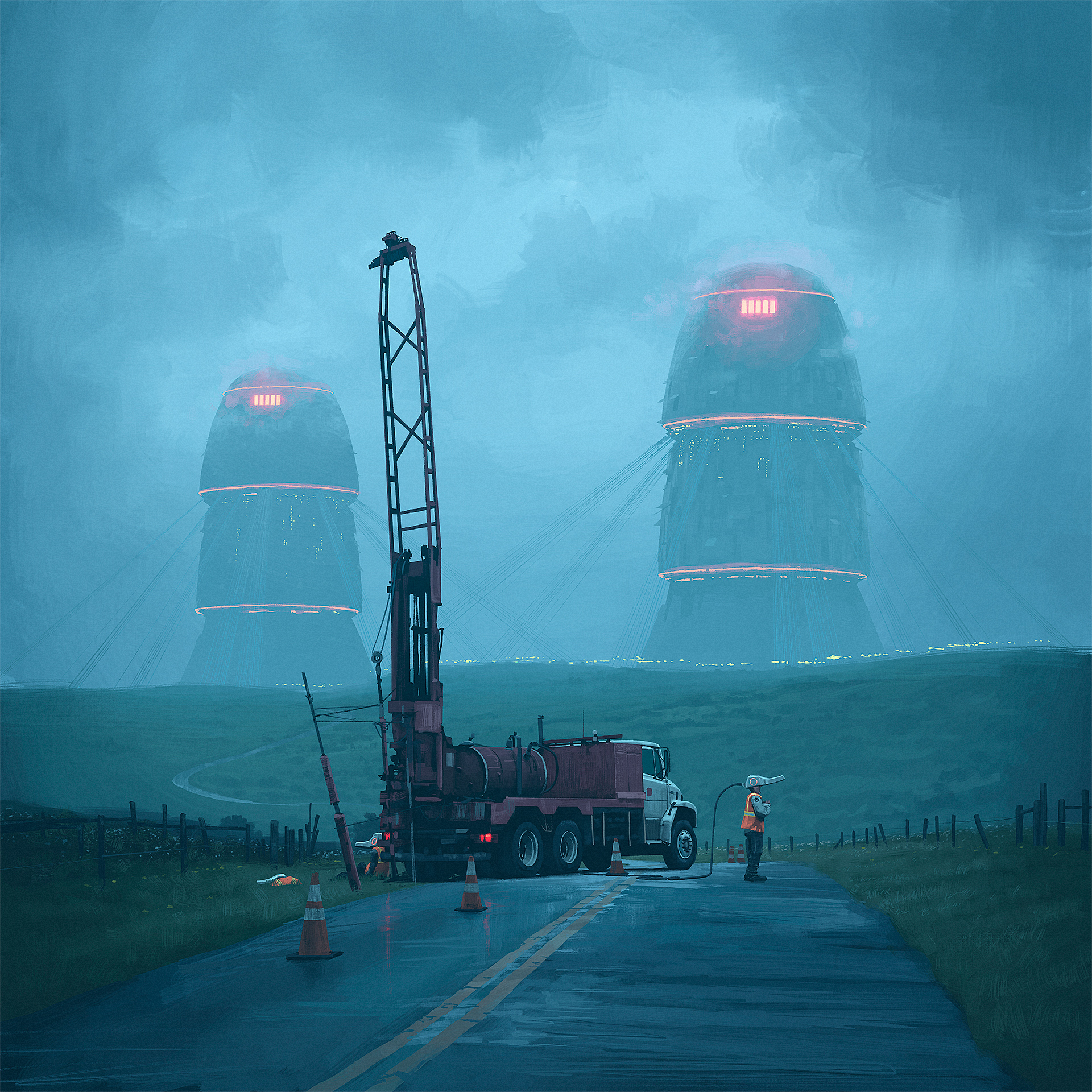
https://www.simonstalenhag.se/bilderbig/by_roadwork_1920.jpg
Recording taken from Zoom Virtual Archives – Data #78614518: Audio of meeting between Henry Maranda, Director of Operations for Duracom Inc., Dean Sampson, Program Manager for Project Gaslight, and Fred Mallery, chief engineer for Project Gaslight. Meeting took place at 10:17am on October 21, 2055.
Maranda: Alright Sampson, what is so important that you had to pull me out of my meeting with the Venezuelans? We have the potential to make billions down there and I still have a lot of negotiating to do before we can get boots on the ground. Make this quick.
Sampson: Good morning sir. Sorry for interrupting you, but I wouldn’t do it unless it was of the utmost importance so that’s…
Maranda: Hold on… who else is in this meeting? I don’t recognize them.
Sampson: Ah, that would be Fred Mallery sir. He is the chief engineer for Project Gaslight. I asked him to join us as he is responsible for finding the flaw…
Maranda: Flaw? What flaw? And catch me up to speed on Gaslight… I know it has something to do with employee productivity but I’ve been so busy with this Venezuelan project that I’ve lost touch.
Sampson: Right… ok. Well, with the onset of this new pandemic we started researching ways in which to keep our employees both working on site and safe from infection. As most of our drilling and resource production takes place away from urban centres, we started looking at ways to keep our employees from traveling back and forth from home and work, thus minimizing infection occurring through people outside their work bubble. Gaslight was the answer. Instead of a crew working an eight-hour shift and then travelling home, they don their headsets and the virtual ocular manipulators replicate the restive state of a normal eight-hour sleep cycle in just two. The employee, ready for another day, takes off their headset, eats the nutrition pouches we supply them, and continues with their work. This drove our productivity rates through the roof as we were completing projects well ahead of schedule and were able to promise completion dates far better than our competition.
Maranda: Right, right… I remember. Gaslight has been quite the boon for the company. And now you’re telling there’s a flaw?
Sampson: Well… yes. You see… maybe I should get Mallery to step in here.
Mallery: Oh, hi… I mean good morning gentlemen. Let me begin by saying it is a great honour to speak with you Mr. Maranda. I have admired your work with neophysicality for…
Maranda: Cut to the chase Mallery.
Mallery: Right. (sound of a cough) So what we have noticed in the past week or so is a dramatic drop in productivity from our Gaslight crews. Actually, as of 1:43am this morning, productivity has hit zero.
Maranda: Excuse me?
Mallery: All job sites are presently at a standstill. No one is working.
Maranda: Don’t tell me they all want to unionize because I will go find workers who will be more than happy to…
Mallery: No, it’s not that. It has to do with the headsets.
Maranda: What? They don’t want to wear them? Listen, these people fully knew what they were signing up for when they took these positions, and they are being thoroughly compensated. If we need to fire a crew to show the rest we mean business…
Sampson: No, it’s not that they don’t want to wear the headsets. It’s that they won’t take them off.
Maranda: What the hell are you talking about?
Mallery: You see, Gaslight is designed around idea of resting an individual’s senses and body though intense virtual euphoria. The subject is surrounded by what they see is their ultimate dream and while they experience this sensation, their body rapidly recovers from the trials of the workday. A side effect, and one we thought beneficial, is that the worker experiences a euphoric feeling at the two-hour mark, which makes them feel even more refreshed and ready to return to work. What we didn’t anticipate was that if they left the headset on after the two-hour mark, the euphoric feeling stayed, though slightly diminished, and then returned with more intensity every two hours. Even without the dream sequence happening, workers are choosing to leave the headsets on for the euphoria.
Maranda: So get someone out there and rip those things from their heads!
Sampson: It’s not that easy. Each headset has been individually set up for each worker and only recognizes their fingerprints and biowaves. Someone else rips it off and it may send a shock through the virtual optics and destroy the wearer’s vision… or brain… we’re not sure.
Maranda: What do you mean “you’re not sure”??!
Mallery: Addiction was never taken into account when we came up with Gaslight. Quite the opposite, we thought that crews would absolutely refuse to wear the headsets. Hence why we were so happy with the euphoria side effect.
Maranda: So what you are telling me is that I have crews of workers across the globe standing around doing nothing like fucking zombie addicts?! Oh my God… how many work sites did we install Gaslight into?
Sampson: Ummm… all of them.
Maranda: What?
Mallery: Preliminary numbers were so enthusiastic that the Board decided to implement Gaslight across the board. It really is quite the invention when you…
Maranda: Shut up. Let me think… (quite a long pause) Ok, how do we fix this? Tell me your ideas… I know you didn’t come here without knowing some way out of this. Let’s hear it.
(Another pause)
Mallery: Well, there is one sure fire way for this to end. We wait for the batteries in the units to die. This will then release all workers from the headsets with no complications whatsoever.
Maranda: Perfect!! I knew you would have an answer… so how long until the batteries die?
Sampson: Well, (cough heard) as we used our most advanced batteries for Gaslight, we are looking at about six to seven months.
Maranda: Jesus Christ…
Sampson: And on top of that, the workers aren’t eating or drinking fluids so they will waste away to nothing and die if we don’t send crews to each site to monitor them and make sure they are properly nourished. If even one dies… the lawsuits…
Maranda: Stop… just… stop. (a beeping is heard) That’s the CEO calling. She wants an update on all our jobs. How am I going… what do I? Alright… you two organize crews to go to each site and start figuring out what we need to keep everyone alive. I will go talk to the CEO and inform her of the “flaw” in Gaslight. Then I think all of us better start getting our resumes in order. Jesus Christ…
Mallery: Again sir, it is an honour to finally…
Call Terminated



